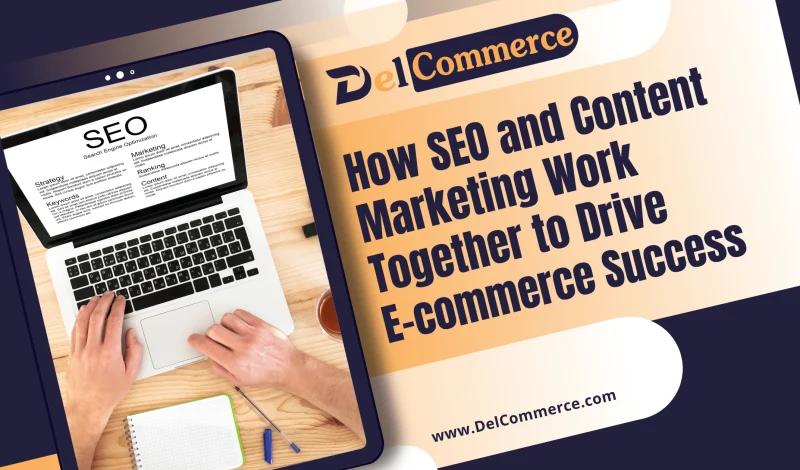The success of any e-commerce business depends on two vital pillars: visibility and engagement. Without the right visibility, your online store remains hidden in a sea of competitors, and without meaningful engagement, even high visibility can fall short of driving conversions. This is where SEO (Search Engine Optimization) and content marketing collaborate to pave the way to e-commerce success. These two elements are not mutually exclusive but rather complementary forces that work together to enhance your online store’s performance.
The Synergy Between SEO and Content Marketing
At first glance, SEO and content marketing may seem like two separate strategies. However, they share a common goal—attracting more qualified traffic to your website. SEO focuses on optimizing your e-commerce site to rank higher in search engines, while content marketing is about creating valuable, relevant content that engages your audience. When combined, they create a robust strategy that addresses both visibility and engagement.
Here’s how these two strategies work together to create a powerhouse of success for your e-commerce business:
1. Driving Organic Traffic with SEO
SEO is the foundation of any online marketing strategy. By optimizing your website, you increase its chances of appearing in search engine results pages (SERPs) for relevant queries. This drives organic traffic—people who are searching for exactly what you’re selling.
- Keyword Research: This is a vital step in SEO. By identifying the keywords that your potential customers are using to search for products, you can tailor your content and product descriptions to match these search terms. The more relevant your content, the higher your chances of ranking on search engines.
- On-Page Optimization: Optimizing each page of your e-commerce site involves placing keywords strategically in product descriptions, meta titles, alt text, and URLs. This makes it easier for search engines like Google to index and rank your pages, ensuring that your products are found by the right customers.
- Technical SEO: Without a solid technical foundation, even the best content won’t rank. Optimizing page speed, ensuring mobile-friendliness, and improving site architecture are crucial to ensure search engines can crawl and index your e-commerce website efficiently.
2. Enhancing Engagement with Content Marketing
While SEO helps you attract visitors, content marketing helps you engage them. Content serves as a magnet, drawing customers in by offering them something of value—whether it’s education, entertainment, or practical information.
- Product Guides and Tutorials: One of the most effective types of content for e-commerce businesses is the product guide. These guides demonstrate how to use your products and show why they are valuable. For example, a skincare e-commerce site might create a guide on “How to Build a Perfect Skincare Routine,” which subtly promotes its products while providing helpful advice.
- Blog Posts for SEO and Authority: Blogs are an essential part of a content marketing strategy because they allow you to rank for long-tail keywords, which are often more specific and less competitive. A well-researched blog post on your e-commerce website can drive significant organic traffic while also positioning your brand as an authority in your niche.
- Video Content: With the rising popularity of video, creating engaging product demos or behind-the-scenes content can foster deeper connections with potential customers. Search engines also rank videos, adding another layer to your SEO strategy.
3. Using SEO to Amplify Content Reach
Creating excellent content is only half the battle. If your content isn’t optimized for search engines, it’s unlikely to reach your target audience. This is where SEO comes back into play to ensure that your content is visible to search engines and users alike.
- Optimizing Content for Keywords: By incorporating relevant keywords naturally into your blog posts, product descriptions, and video titles, you’re signaling to search engines what your content is about. This increases your chances of ranking for those terms.
- Internal Linking: Internal links between your product pages and blog posts can help distribute SEO value across your site, making it easier for search engines to discover and rank your pages. For instance, linking a blog post about summer fashion trends to the related product category increases the likelihood that customers will make a purchase.
4. Building Authority with High-Quality Backlinks
One of the most challenging aspects of SEO is building authority, and this is where content marketing can lend a helping hand. When you create valuable, shareable content, other websites are more likely to link back to it. These backlinks are like votes of confidence from other sites, boosting your SEO rankings and driving referral traffic.
- Guest Blogging and Partnerships: Partnering with relevant influencers or writing guest posts for authoritative websites in your niche can earn you high-quality backlinks that boost your e-commerce site’s authority.
- Infographics and Data-Driven Content: Visual content, such as infographics, is highly shareable. By creating and distributing informative infographics, you increase your chances of earning backlinks from other websites.
5. Content Marketing Fuels Long-Term SEO Success
Unlike paid ads, which only work as long as you’re spending money, content marketing and SEO provide long-lasting results. A well-written, optimized blog post can continue to bring in traffic months or even years after it’s published. This evergreen content not only boosts SEO but also continues to engage potential customers over time.
- Evergreen Content: By focusing on creating content that remains relevant, such as product guides or how-to articles, you’re building a resource library that consistently drives organic traffic.
- Updating Old Content: As search algorithms evolve, so should your content. Periodically updating old blog posts to reflect new trends or information can give them a fresh SEO boost and ensure they remain relevant.
6. Boosting Conversions with SEO-Driven Content
Ultimately, the goal of combining SEO and content marketing is to drive conversions. By ensuring that your e-commerce site ranks highly and provides valuable content, you’re building trust with your audience and guiding them through the sales funnel.
- Optimizing Product Pages: SEO doesn’t stop at blog posts. Optimizing product pages with detailed descriptions, high-quality images, and customer reviews enhances the user experience and increases the likelihood of conversion.
- Creating Content for Each Stage of the Buyer’s Journey: Different types of content appeal to customers at various stages of the buying process. Informative blog posts help attract new customers, while case studies and product comparisons help close the deal. A balanced content strategy that includes content for each stage ensures that you’re guiding customers from awareness to purchase.
Conclusion: The Power of SEO and Content Marketing for E-Commerce
In today’s digital landscape, SEO and content marketing are a dynamic duo for driving e-commerce success. By focusing on both strategies, you can attract more traffic, engage your audience, and convert visitors into loyal customers. Remember, it’s not just about getting people to your site—it’s about keeping them engaged and guiding them through the buying process with valuable content.
At DelCommerce, we specialize in helping e-commerce businesses like yours grow through integrated SEO and content marketing strategies. Ready to take your online store to the next level? Contact us today to learn more about our tailored services.




Comment (1)
I genuinely prize your work, Great post.